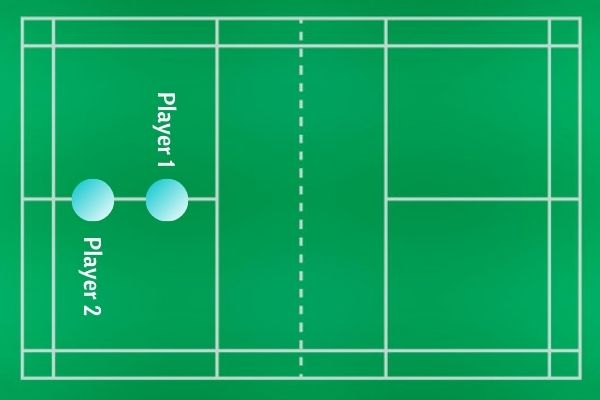Badminton doubles is a completely different game than the singles game. Even if you’re a pretty good singles player, you can’t be good at doubles unless you have a great synchronization with your partner.
There are different positions that you can use as a team to play a strategic doubles game. Positioning is as important in doubles as footwork in singles.
If you’re a complete beginner in badminton doubles, you and your partner need to understand the basics of positioning in badminton doubles.
Don’t worry if you don’t understand the basic positioning in doubles. In this article, we will go through the important things so that you’ll become a great doubles player.
Let’s jump right in.
What Is Positioning In Badminton Doubles?
In badminton doubles, there are mainly two formations: attacking formation and defensive formation. Players need to use either of these two formations according to the situation of the rally.
If your team is taking the attack on your opponents, then you need to follow the attacking formation. If the opponents are hitting hard smashed to your court, then you need to be in the defensive formation.
Let’s look at the two of these formations in detail and understand the strategies.
Attacking Formation
The attacking formation in badminton needs one player to stand behind the other. Take a look at the picture given below to understand the positions.

In the attacking formation, both the players have different roles. The player who is standing behind (attacker) is responsible for hitting the attacking shots from the back of the court. Most often, he needs to hit hard smashes to keep on attacking. Sometimes, he can play the drop shots or other shots according to the situation.
The player who is standing in the front (setter) is the one who is responsible for securing the net position. This player can keep on hitting smashes to make the opponents lift the shuttle. If he gets a loose shot in the air, he can perform a net kill and end the rally.
The attacker needs to cover the back of the court, whereas the setter is in charge of covering the front of the court.
Most often, when the player who is standing behind hits a hard smash, the return will be a short defensive clear, and that will be an easy chance for the setter to hit a net kill.
The setter can intercept short and poor-quality defensive shots and smash them to end the rally. Both the players need to be in complete synchronization to attack the opponents efficiently without giving them a chance to come back in the rally.
If the opponents come back in the rally and gain the attacking position somehow, then your team should quickly change the formation to a defensive one.
Now, let’s understand what the defensive formation is in badminton doubles.
Defensive Formation
The defensive formation in badminton requires the two players to stand side-by-side to cover the entire width of the doubles court. In this formation, each player will cover their respective sides.
Take a look at the following image to understand the positioning in the defensive formation.

Whenever you are required to hit a high clear or high lift, then you need to quickly form the defensive formation so that you’ll be ready for an attacking smash from the opponents.
If you don’t cover the full width of the court using this formation, it will be easy for your opponents to pick a point by hitting a well-placed smash shot or a drop shot. So, whenever your team is under pressure, quickly form the defensive formation to cover the entire court.
You need to try to stand around the middle of the court, maybe a step behind the mid-court area, so that you’ll be able to react to the smashes along with taking the drop shots near the net.
When you return the hard smashes, try to hit a block defense and lift the shuttle back to the baseline of the opponent’s court. Do not hit a weak clear shot to the front or middle of the opponent’s court.
That will give the opponents a chance to kill the rally. Don’t give the setter of the opposite team a chance to intercept the return. Always try to hit the returns to the baseline.
Your position needs to vary slightly according to the shots. If you’re lifting the shuttle to the left side of the opponent’s court, then the left defender needs to cover the left corner of the court since the return will most probably be a straight smash. Then, the right defender needs to cover the middle of the court.
Even if the attacker hits a cross-court smash to the right side of your court, the right defender will have the time to move and pick that shot. So, you need to adjust the defensive formation according to the attacker’s position.
Whenever you get a chance to attack from a defensive position, hit a smash or drop and come back to the attacking formation. Make the opponents keep on lifting the shuttle so that you can gain control of the rally.
How To Change Formations Correctly?
How can you switch between the two formations correctly according to the game situations? Well, you can’t just plan about the formation and move accordingly when the rally is going on. You need to have a plan before the game and enough practice.
You need to practice the attacking and defensive formations and how to change the two formations. Initially, you might need to call out and change the formations based on the call. The player who is standing behind makes the call because the setter can’t see the attacker.
So, if the attacker hits a smash or a drop, he can call out “attack”, and they can be in the attacking formation. If the attacker hits a lift or clear, he can call out “defend”, and they can move to the defensive formation.
It is a little bit tricky thing. You need to have enough practice and coordination to master the formation change. If you’re confused, take a look at the following video and understand how you should change the formations.
As you’ve seen in the video, try to practice the formation change with your partner. It is very difficult for beginners. Remember that you’ll make a lot of mistakes. It will take some time and practice to get things right. Keep on practicing until you become pretty good at it.
Always give priority to the attacking formation. You should try to be in the attacking formation as long as possible. If you’re in a defensive formation, try to come back to the attacking formation (by fighting for the next attack) as soon as you can.
Final Thoughts
We’ve covered the basics of footwork and positioning in badminton doubles. If you’ve understood the theoretical concepts, put that into practice, and you’ll definitely become good at doubles.
I hope this article was helpful to you in learning something new about badminton. Check out the rest of the articles on this site to get more badminton tips and tricks.
If this article was useful to you, give it a share so that others will also find it.
If you want to know how to play badminton doubles with a weak partner, check out this complete guide.
Thanks for reading. Enjoy badminton!

